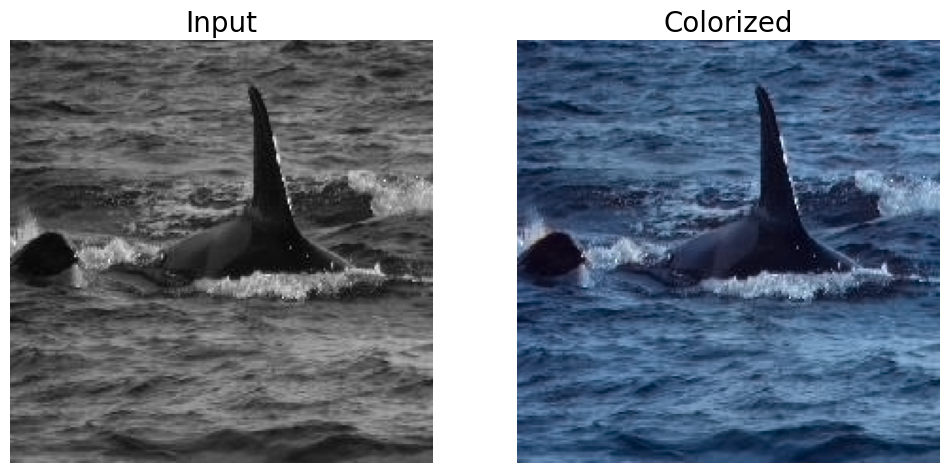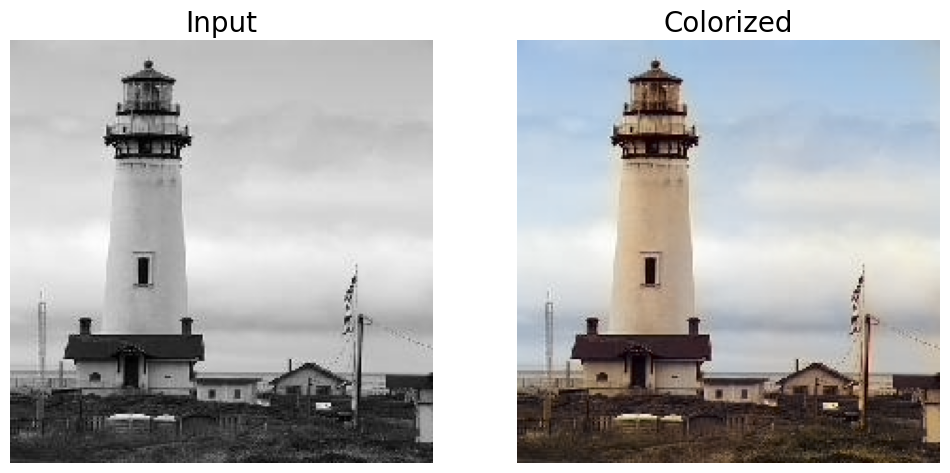Image Colorization with OpenVINO#
This Jupyter notebook can be launched on-line, opening an interactive environment in a browser window. You can also make a local installation. Choose one of the following options:
This notebook demonstrates how to colorize images with OpenVINO using the Colorization model colorization-v2 or colorization-siggraph from Open Model Zoo based on the paper Colorful Image Colorization models from Open Model Zoo.

Let there be color#
Given a grayscale image as input, the model generates colorized version of the image as the output.
About Colorization-v2#
The colorization-v2 model is one of the colorization group of models designed to perform image colorization.
Model trained on the ImageNet dataset.
Model consumes L-channel of LAB-image as input and produces predict A- and B-channels of LAB-image as output.
About Colorization-siggraph#
The colorization-siggraph model is one of the colorization group of models designed to real-time user-guided image colorization.
Model trained on the ImageNet dataset with synthetically generated user interaction.
Model consumes L-channel of LAB-image as input and produces predict A- and B-channels of LAB-image as output.
See the colorization repository for more details.
Table of contents:#
import platform
%pip install "openvino-dev>=2024.0.0" opencv-python tqdm
if platform.system() != "Windows":
%pip install -q "matplotlib>=3.4"
else:
%pip install -q "matplotlib>=3.4,<3.7"
Requirement already satisfied: openvino-dev>=2024.0.0 in /opt/home/k8sworker/ci-ai/cibuilds/ov-notebook/OVNotebookOps-674/.workspace/scm/ov-notebook/.venv/lib/python3.8/site-packages (2024.1.0) Requirement already satisfied: opencv-python in /opt/home/k8sworker/ci-ai/cibuilds/ov-notebook/OVNotebookOps-674/.workspace/scm/ov-notebook/.venv/lib/python3.8/site-packages (4.9.0.80) Requirement already satisfied: tqdm in /opt/home/k8sworker/ci-ai/cibuilds/ov-notebook/OVNotebookOps-674/.workspace/scm/ov-notebook/.venv/lib/python3.8/site-packages (4.66.4) Requirement already satisfied: defusedxml>=0.7.1 in /opt/home/k8sworker/ci-ai/cibuilds/ov-notebook/OVNotebookOps-674/.workspace/scm/ov-notebook/.venv/lib/python3.8/site-packages (from openvino-dev>=2024.0.0) (0.7.1) Requirement already satisfied: networkx<=3.1.0 in /opt/home/k8sworker/ci-ai/cibuilds/ov-notebook/OVNotebookOps-674/.workspace/scm/ov-notebook/.venv/lib/python3.8/site-packages (from openvino-dev>=2024.0.0) (3.1) Requirement already satisfied: numpy<2.0.0,>=1.16.6 in /opt/home/k8sworker/ci-ai/cibuilds/ov-notebook/OVNotebookOps-674/.workspace/scm/ov-notebook/.venv/lib/python3.8/site-packages (from openvino-dev>=2024.0.0) (1.23.5) Requirement already satisfied: openvino-telemetry>=2023.2.1 in /opt/home/k8sworker/ci-ai/cibuilds/ov-notebook/OVNotebookOps-674/.workspace/scm/ov-notebook/.venv/lib/python3.8/site-packages (from openvino-dev>=2024.0.0) (2024.1.0) Requirement already satisfied: packaging in /opt/home/k8sworker/ci-ai/cibuilds/ov-notebook/OVNotebookOps-674/.workspace/scm/ov-notebook/.venv/lib/python3.8/site-packages (from openvino-dev>=2024.0.0) (24.0) Requirement already satisfied: pyyaml>=5.4.1 in /opt/home/k8sworker/ci-ai/cibuilds/ov-notebook/OVNotebookOps-674/.workspace/scm/ov-notebook/.venv/lib/python3.8/site-packages (from openvino-dev>=2024.0.0) (6.0.1) Requirement already satisfied: requests>=2.25.1 in /opt/home/k8sworker/ci-ai/cibuilds/ov-notebook/OVNotebookOps-674/.workspace/scm/ov-notebook/.venv/lib/python3.8/site-packages (from openvino-dev>=2024.0.0) (2.31.0) Requirement already satisfied: openvino==2024.1.0 in /opt/home/k8sworker/ci-ai/cibuilds/ov-notebook/OVNotebookOps-674/.workspace/scm/ov-notebook/.venv/lib/python3.8/site-packages (from openvino-dev>=2024.0.0) (2024.1.0) Requirement already satisfied: charset-normalizer<4,>=2 in /opt/home/k8sworker/ci-ai/cibuilds/ov-notebook/OVNotebookOps-674/.workspace/scm/ov-notebook/.venv/lib/python3.8/site-packages (from requests>=2.25.1->openvino-dev>=2024.0.0) (3.3.2) Requirement already satisfied: idna<4,>=2.5 in /opt/home/k8sworker/ci-ai/cibuilds/ov-notebook/OVNotebookOps-674/.workspace/scm/ov-notebook/.venv/lib/python3.8/site-packages (from requests>=2.25.1->openvino-dev>=2024.0.0) (3.7) Requirement already satisfied: urllib3<3,>=1.21.1 in /opt/home/k8sworker/ci-ai/cibuilds/ov-notebook/OVNotebookOps-674/.workspace/scm/ov-notebook/.venv/lib/python3.8/site-packages (from requests>=2.25.1->openvino-dev>=2024.0.0) (2.2.1) Requirement already satisfied: certifi>=2017.4.17 in /opt/home/k8sworker/ci-ai/cibuilds/ov-notebook/OVNotebookOps-674/.workspace/scm/ov-notebook/.venv/lib/python3.8/site-packages (from requests>=2.25.1->openvino-dev>=2024.0.0) (2024.2.2) DEPRECATION: pytorch-lightning 1.6.5 has a non-standard dependency specifier torch>=1.8.*. pip 24.1 will enforce this behaviour change. A possible replacement is to upgrade to a newer version of pytorch-lightning or contact the author to suggest that they release a version with a conforming dependency specifiers. Discussion can be found at pypa/pip#12063 Note: you may need to restart the kernel to use updated packages. DEPRECATION: pytorch-lightning 1.6.5 has a non-standard dependency specifier torch>=1.8.*. pip 24.1 will enforce this behaviour change. A possible replacement is to upgrade to a newer version of pytorch-lightning or contact the author to suggest that they release a version with a conforming dependency specifiers. Discussion can be found at pypa/pip#12063 Note: you may need to restart the kernel to use updated packages.
Imports#
import os
from pathlib import Path
import cv2
import matplotlib.pyplot as plt
import numpy as np
import openvino as ov
# Fetch `notebook_utils` module
import requests
r = requests.get(
url="https://raw.githubusercontent.com/openvinotoolkit/openvino_notebooks/latest/utils/notebook_utils.py",
)
open("notebook_utils.py", "w").write(r.text)
import notebook_utils as utils
Configurations#
PRECISION- {FP16, FP32}, default: FP16.MODEL_DIR- directory where the model is to be stored, default: public.MODEL_NAME- name of the model used for inference, default: colorization-v2.DATA_DIR- directory where test images are stored, default: data.
PRECISION = "FP16"
MODEL_DIR = "models"
MODEL_NAME = "colorization-v2"
# MODEL_NAME="colorization-siggraph"
MODEL_PATH = f"{MODEL_DIR}/public/{MODEL_NAME}/{PRECISION}/{MODEL_NAME}.xml"
DATA_DIR = "data"
Select inference device#
select device from dropdown list for running inference using OpenVINO
import ipywidgets as widgets
core = ov.Core()
device = widgets.Dropdown(
options=core.available_devices + ["AUTO"],
value="AUTO",
description="Device:",
disabled=False,
)
device
Dropdown(description='Device:', index=1, options=('CPU', 'AUTO'), value='AUTO')
omz_downloader downloads model files from online sources and, if
necessary, patches them to make them more usable with Model Converter.
In this case, omz_downloader downloads the checkpoint and pytorch
model of
colorization-v2
or
colorization-siggraph
from Open Model
Zoo
and saves it under MODEL_DIR, as specified in the configuration
above.
download_command = f"omz_downloader " f"--name {MODEL_NAME} " f"--output_dir {MODEL_DIR} " f"--cache_dir {MODEL_DIR}"
! $download_command
################|| Downloading colorization-v2 ||################
========== Downloading models/public/colorization-v2/ckpt/colorization-v2-eccv16.pth
========== Downloading models/public/colorization-v2/model/__init__.py
========== Downloading models/public/colorization-v2/model/base_color.py
========== Downloading models/public/colorization-v2/model/eccv16.py
========== Replacing text in models/public/colorization-v2/model/__init__.py
========== Replacing text in models/public/colorization-v2/model/__init__.py
========== Replacing text in models/public/colorization-v2/model/eccv16.py
omz_converter converts the models that are not in the OpenVINO™ IR
format into that format using model conversion API.
The downloaded pytorch model is not in OpenVINO IR format which is
required for inference with OpenVINO runtime. omz_converter is used
to convert the downloaded pytorch model into ONNX and OpenVINO IR format
respectively
if not os.path.exists(MODEL_PATH):
convert_command = f"omz_converter " f"--name {MODEL_NAME} " f"--download_dir {MODEL_DIR} " f"--precisions {PRECISION}"
! $convert_command
========== Converting colorization-v2 to ONNX
Conversion to ONNX command: /opt/home/k8sworker/ci-ai/cibuilds/ov-notebook/OVNotebookOps-674/.workspace/scm/ov-notebook/.venv/bin/python -- /opt/home/k8sworker/ci-ai/cibuilds/ov-notebook/OVNotebookOps-674/.workspace/scm/ov-notebook/.venv/lib/python3.8/site-packages/omz_tools/internal_scripts/pytorch_to_onnx.py --model-path=models/public/colorization-v2 --model-name=ECCVGenerator --weights=models/public/colorization-v2/ckpt/colorization-v2-eccv16.pth --import-module=model --input-shape=1,1,256,256 --output-file=models/public/colorization-v2/colorization-v2-eccv16.onnx --input-names=data_l --output-names=color_ab
ONNX check passed successfully.
========== Converting colorization-v2 to IR (FP16)
Conversion command: /opt/home/k8sworker/ci-ai/cibuilds/ov-notebook/OVNotebookOps-674/.workspace/scm/ov-notebook/.venv/bin/python -- /opt/home/k8sworker/ci-ai/cibuilds/ov-notebook/OVNotebookOps-674/.workspace/scm/ov-notebook/.venv/bin/mo --framework=onnx --output_dir=models/public/colorization-v2/FP16 --model_name=colorization-v2 --input=data_l --output=color_ab --input_model=models/public/colorization-v2/colorization-v2-eccv16.onnx '--layout=data_l(NCHW)' '--input_shape=[1, 1, 256, 256]' --compress_to_fp16=True
[ INFO ] Generated IR will be compressed to FP16. If you get lower accuracy, please consider disabling compression explicitly by adding argument --compress_to_fp16=False.
Find more information about compression to FP16 at https://docs.openvino.ai/2023.0/openvino_docs_MO_DG_FP16_Compression.html
[ INFO ] MO command line tool is considered as the legacy conversion API as of OpenVINO 2023.2 release. Please use OpenVINO Model Converter (OVC). OVC represents a lightweight alternative of MO and provides simplified model conversion API.
Find more information about transition from MO to OVC at https://docs.openvino.ai/2023.2/openvino_docs_OV_Converter_UG_prepare_model_convert_model_MO_OVC_transition.html
[ SUCCESS ] Generated IR version 11 model.
[ SUCCESS ] XML file: /opt/home/k8sworker/ci-ai/cibuilds/ov-notebook/OVNotebookOps-674/.workspace/scm/ov-notebook/notebooks/vision-image-colorization/models/public/colorization-v2/FP16/colorization-v2.xml
[ SUCCESS ] BIN file: /opt/home/k8sworker/ci-ai/cibuilds/ov-notebook/OVNotebookOps-674/.workspace/scm/ov-notebook/notebooks/vision-image-colorization/models/public/colorization-v2/FP16/colorization-v2.bin
Load the model in OpenVINO Runtime with ie.read_model and compile it
for the specified device with ie.compile_model.
core = ov.Core()
model = core.read_model(model=MODEL_PATH)
compiled_model = core.compile_model(model=model, device_name=device.value)
input_layer = compiled_model.input(0)
output_layer = compiled_model.output(0)
N, C, H, W = list(input_layer.shape)
def read_image(impath: str) -> np.ndarray:
"""
Returns an image as ndarra, given path to an image reads the
(BGR) image using opencv's imread() API.
Parameter:
impath (string): Path of the image to be read and returned.
Returns:
image (ndarray): Numpy array representing the read image.
"""
raw_image = cv2.imread(impath)
if raw_image.shape[2] > 1:
image = cv2.cvtColor(cv2.cvtColor(raw_image, cv2.COLOR_BGR2GRAY), cv2.COLOR_GRAY2RGB)
else:
image = cv2.cvtColor(image, cv2.COLOR_GRAY2RGB)
return image
def plot_image(image: np.ndarray, title: str = "") -> None:
"""
Given a image as ndarray and title as string, display it using
matplotlib.
Parameters:
image (ndarray): Numpy array representing the image to be
displayed.
title (string): String representing the title of the plot.
Returns:
None
"""
plt.imshow(image)
plt.title(title)
plt.axis("off")
plt.show()
def plot_output(gray_img: np.ndarray, color_img: np.ndarray) -> None:
"""
Plots the original (bw or grayscale) image and colorized image
on different column axes for comparing side by side.
Parameters:
gray_image (ndarray): Numpy array representing the original image.
color_image (ndarray): Numpy array representing the model output.
Returns:
None
"""
fig = plt.figure(figsize=(12, 12))
ax1 = fig.add_subplot(1, 2, 1)
plt.title("Input", fontsize=20)
ax1.axis("off")
ax2 = fig.add_subplot(1, 2, 2)
plt.title("Colorized", fontsize=20)
ax2.axis("off")
ax1.imshow(gray_img)
ax2.imshow(color_img)
plt.show()
img_url_0 = "https://user-images.githubusercontent.com/18904157/180923287-20339d01-b1bf-493f-9a0d-55eff997aff1.jpg"
img_url_1 = "https://user-images.githubusercontent.com/18904157/180923289-0bb71e09-25e1-46a6-aaf1-e8f666b62d26.jpg"
image_file_0 = utils.download_file(
img_url_0,
filename="test_0.jpg",
directory="data",
show_progress=False,
silent=True,
timeout=30,
)
assert Path(image_file_0).exists()
image_file_1 = utils.download_file(
img_url_1,
filename="test_1.jpg",
directory="data",
show_progress=False,
silent=True,
timeout=30,
)
assert Path(image_file_1).exists()
test_img_0 = read_image("data/test_0.jpg")
test_img_1 = read_image("data/test_1.jpg")
def colorize(gray_img: np.ndarray) -> np.ndarray:
"""
Given an image as ndarray for inference convert the image into LAB image,
the model consumes as input L-Channel of LAB image and provides output
A & B - Channels of LAB image. i.e returns a colorized image
Parameters:
gray_img (ndarray): Numpy array representing the original
image.
Returns:
colorize_image (ndarray): Numpy arrray depicting the
colorized version of the original
image.
"""
# Preprocess
h_in, w_in, _ = gray_img.shape
img_rgb = gray_img.astype(np.float32) / 255
img_lab = cv2.cvtColor(img_rgb, cv2.COLOR_RGB2Lab)
img_l_rs = cv2.resize(img_lab.copy(), (W, H))[:, :, 0]
# Inference
inputs = np.expand_dims(img_l_rs, axis=[0, 1])
res = compiled_model([inputs])[output_layer]
update_res = np.squeeze(res)
# Post-process
out = update_res.transpose((1, 2, 0))
out = cv2.resize(out, (w_in, h_in))
img_lab_out = np.concatenate((img_lab[:, :, 0][:, :, np.newaxis], out), axis=2)
img_bgr_out = np.clip(cv2.cvtColor(img_lab_out, cv2.COLOR_Lab2RGB), 0, 1)
colorized_image = (cv2.resize(img_bgr_out, (w_in, h_in)) * 255).astype(np.uint8)
return colorized_image
color_img_0 = colorize(test_img_0)
color_img_1 = colorize(test_img_1)
plot_output(test_img_0, color_img_0)

plot_output(test_img_1, color_img_1)
